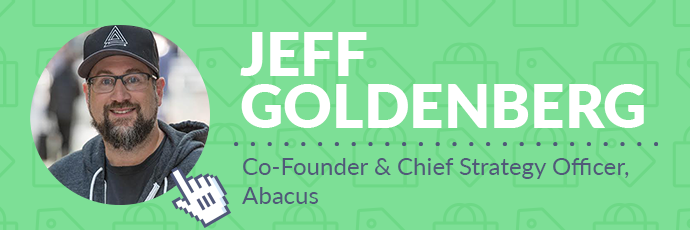Ecommerce data myths are everywhere.
Why?
Because at the risk of being obvious: data matters.
Unfortunately, few words are as hyped as: data-focused, data-centric, data-obsessed, data-uniting, and—of course—data-driven.
Talking about eCommerce data is easy. Separating data-truth from data-myth…is hard.
That’s why, to cut through the BS, I connected with 16 eCommerce thought leaders in both B2C and B2B eCommerce who are relentlessly focused on data. I asked them each three questions:
- What makes you “data driven”?
- What’s the biggest “best practice” myth in ecommerce?
- What analytics tool do you recommend for ecommerce?
- 1. Linda Bustos, Co-founder and Managing Partner at Edgacent
- 2. Tomer Tagrin, CEO and Co-founder at Yotpo
- 3. Talia Wolf, Conversion Optimization Expert and FounderatGetUplift
- 4. Ben Carpel, CEO at Cyfe
- 5. William Harris, eCommerce Consultant at Elumynt
- 6. Neil Patel, Founder at NeilPatel.com
- 7. Claire Vignon, Director of Optimization Strategy at WiderFunnel
- 8. Tommy Walker, Editor in Chief at Shopify Plus
- 9. Paul Rouke, Founder and CEO at PRWD
- 10. Shayla Price, B2B Content Marketer
- 11. Mark Hayes, Chief Marketing Officer at Rocketshp
- 12. Jeff Goldenberg, Co-Founder and Chief Strategy Officer at Abacus
- 13. Adii Pienaar, Founder and “High King of Ecommerce” at Conversio
- 14. Gary Landa, Managing Director at Digital Boutique
- 15. Shanelle Mullin, Content & Growth at CXL
- 16. Nemo Chu, CEO at cuco.co inc. & Marketing Coach at 500 Startups
- The big takeaways
Get brand new conversion strategies straight to your inbox every week. 23,739 people already are!
1. Linda Bustos, Co-founder and Managing Partner at Edgacent

What makes you “data driven”?
I've spent the past decade helping online retailers -- both large and small -- improve their front-end experiences and conversion rates. I’ve also worked with some of the largest brands in the world, including Google, Symantec, Sony, Intuit and Comcast.
What’s the biggest “best practice” myth in ecommerce?
This may be controversial, but I believe it's a myth that "there are no best practices" and you must test every design change before rolling it out.
Common sense, “captain obvious” fixes can be applied without the overhead of an A/B test, saving your test resources for hypotheses you're less sure about. For example, adding finger-friendly Prev and Next buttons alongside paginated links (or in place of) is a true best practice and a vast improvement over a series of tiny, squishy numbers.
What analytics tool do you recommend for ecommerce?
Google Analytics is a good low-cost standard, but it's not super merchandiser friendly.
Tools like Jirafe and Bloomreach that visually show product click through rates within product categories and for popular searches can help you optimize your merchandising on a daily basis, which is the missing piece for many ecommerce sites.
Analytics and A/B testing can help you improve the "container" of your ecommerce site, but optimizing product presentation helps the customer’s journey and can have a significant impact on conversion rates, basket size and revenue.
2. Tomer Tagrin, CEO and Co-founder at Yotpo

What makes you “data driven”?
In order to be a data-driven expert in ecommerce, you can't just look at data in one specific vertical or one sample size.
One example is our latest project, Data Labs by Yotpo, which crunches the numbers from over 559,276,000 shoppers, 163,199,478 orders, and 21,070,132 customer reviews to find actionable takeaways for ecommerce businesses that want to be on top of the latest trends.
What’s the biggest “best practice” myth in ecommerce?
Today, too many ecommerce marketers still believe that the best way to get new customers is to bring them to you.
This is an enormous myth, because ecommerce stores' biggest marketing asset is the customers they already have. Examples of brands like Warby Parker and Glossier prove that building a customer community of brand advocates is the most sustainable strategy.
We're moving towards a future that's not about a brand marketing for customers, but customers marketing for businesses.
What analytics tool do you recommend for ecommerce?
The best analytics tool is one that gives you actionable insights based on your data. Too many tools focus on just one segment of the buyer journey (traffic, conversion, etc.).
Our analytics tools focus on everything, from paid and organic traffic acquisition, to customer engagement and response rate, to opportunities to increase conversion.
3. Talia Wolf, Conversion Optimization Expert and Founder at GetUplift

What makes you “data driven”?
I've been doing conversion optimization for over 7 years now. My main focus is emotional targeting and consumer psychology; this means that I use the power of emotion to increase my clients' conversion rates.
Here's why: Most optimizers focus on finding the leak in the funnel via tools such as Google Analytics or heatmaps and then when it comes to deciding what to test, they basically guess, follow "best practices" (which are a complete waste of time), cross their fingers and hope for the best. This leads to meaningless results and this is why most optimizers feel frustrated with CRO: they put in tons of time, resources and effort only to get nothing.
The emotional targeting methodology helps me come up with testing ideas, hypotheses and, most importantly, helps me understand who my customer is. Simply put, the root to every conversion is human decision making - if you can understand why people make decisions, why people want to buy your product - you can create a better experience for them.
What’s the biggest “best practice” myth in ecommerce?
Let's just get one thing straight, best practices suck and are worthless. They offer meaningless shortcuts to marketers by providing them with tips such as “reduce the amount of fields you have in a form.” These blog posts are written by publishers who want more traffic and click bait, which is why most of them are titled something like “The 1 tip that increases revenues by 780% every single time.”
For example, reducing the amount of fields in a form might increase your immediate conversions, but not necessarily. I've seen it work quite the opposite countless times. More fields may cause less immediate conversions, but those who spend the time filling in all the information are usually those who become lifelong customers. Retention is the name of the game in ecommerce; our goal isn't just to get them to buy one time, but to keep them coming back, become loyal customers, recommend us to others and more.
Another myth that suffers from the same issue is allowing guest checkout. This is controversial but we've tested it many times and for many websites, requiring signup works better. Why? Because email is the biggest river of ecommerce conversions and once they've signed up it's easier to retain them, increase returning customers, show personalized recommendations and more.
What analytics tool do you recommend for ecommerce?
While most experts say you should be data driven, I believe you should be data informed, yet customer driven. Your number one goal should be: make it about the customer.
For analytical research: Google Analytics, heatmaps (e.g., HotJar), Mixpanel, and CRM data. For more profound research and getting to know your customers, conduct on-site surveys, interviews, and competitor research.
4. Ben Carpel, CEO at Cyfe

What makes you “data driven”?
As the founder of an analytics dashboard company, I see first-hand the catastrophes caused by not just bad data but fragmented data and too much data. This affects everyone from startups, to small and medium enterprises (SMEs) to Fortune 500 multinationals. Having worked closely with a number of our 225,000 plus user base, I’ve been given the opportunity to not just coach, but learn about ecommerce from the front lines.
What’s the biggest “best practice” myth in ecommerce?
One myth I commonly see is that likes and a social fanbase automatically equals ecommerce sales. Some merchants pay too much attention to social metrics.
That can be an important signal, channel for ecommerce customer acquisition, or vehicle for getting the word out about your products, but conversion and shopping cart metrics from tools like Google Analytics, WooCommerce, and Shopify are far more useful.
What analytics tool do you recommend for ecommerce?
I mentioned a few, but naturally I’d also recommend Cyfe – which is seriously useful for anyone beginning or getting more advanced with data.
Exactly what tool you use to connect all the other tools – we’ve got pre-built widgets for Google Analytics, Mixpanel, Chartbeat, WooCommerce, Shopify, Magento and more – isn’t the point. The key is to bring them together somewhere and analyze what’s occurring across your ecommerce operation as a whole.
5. William Harris, eCommerce Consultant at Elumynt

What makes you “data driven”?
I focus on the data because every store is different; therefore, the approach to growth should be customized. I start with digging into an ecommerce store's data and let it tell me a story. I use that story to direct me in the fastest, most efficient route to grow sales. With one client, we changed some navigational elements and improved category sales by 77% in less than a month. With another, we found a whole bunch of wins in the data and improved site wide sales by over 40% YoY.
I spoke at IRCE last year on Google Shopping and data feed management (super nerdy stuff), and part of the discussion involved bidding at the SKU level. This requires a deeper understanding of the profit margins of each SKU. It's not for people that are afraid of data.
What’s the biggest “best practice” myth in ecommerce?
Free Shipping. There's a ton of data that suggests you can make a lot more sales by offering free shipping. And that's true to some extent. I've had the privilege of working alongside merchants that decided to offer Free Shipping. The result has almost always been the same: the increase in sales was not enough to make up for the lost revenue in shipping.
Maybe it was short-sighted for them to turn off the free shipping test after one quarter, but you have to be aware of your margins and profitability. If free shipping means you don't have enough margin to advertise anymore, it's really going to stunt your growth.
What analytics tool do you recommend for ecommerce?
It's not about one tool. But if you can only have one, Google Analytics is the best (make sure you have Enhanced Ecommerce turned on).
There are other tools that can tell you more details about other parts of your business. Moz is great for SEO, Sellbrite (a company I'm affiliated with) is great for sales across all channels, like ebay, Amazon, Shopify, etc., and dozens of other apps for getting deeper insights into niche parts of your store.
The goal then is to get all of that data merged together using a tool like Chartio, or Domo. RJMetrics is another great tool, but these tools aren't cheap, and in my opinion, are a bit like buying a racecar and not knowing how to drive it. If you're serious about being “data-driven,” you need a driver - you need an analyst that can take all of that information and turn it into real insights.
6. Neil Patel, Founder at NeilPatel.com

What makes you “data driven”?
I’m the co-founder of two analytics companies: Crazy Egg and KISSmetrics. I’ve also done marketing consulting for the two largest commerce companies in the US … Amazon and eBay.
What’s the biggest “best practice” myth in ecommerce?
After those name drops, it might sound strange but too many companies believe that if they follow what the giants like Amazon are doing, they’ll grow. What works for Amazon in most cases won’t work for you. Given the size of Amazon, they can take a pretty laxed approach to personalization, especially when it comes to recommended products. Niche ecommerce sites can’t.
Running alongside that is the myth that everything begins and ends with numbers. Instead of jumping head first into an A/B test, start by getting to know your users and customers. Go for real feedback. And always A/A test before you A/B test.
What analytics tool do you recommend for ecommerce?
There isn’t just one perfect tool. You can rule the data world with Google Analytics, Crazy Egg, Hello Bar, and an excel spreadsheet.
7. Claire Vignon, Director of Optimization Strategy at WiderFunnel

What makes you “data driven”?
I’ve ran hundreds of A/B tests that generated profitable “aha!” moments for Fortune 500 ecommerce companies across industries from fashion to electronics.
What’s the biggest “best practice” myth in ecommerce?
I wrote a blog post a few years ago about why retailers should stop copying Amazon after we ran a test for a client who was determined to change their site navigation the way Amazon was doing it. None of the Amazon-like variations ended up outperforming the original navigation.
What works for Amazon may not work for another e-commerce company for different reasons:
First, most e-commerce companies have more differences than similarities to Amazon. Even if they sell the same products, their value proposition is hopefully different. If not, they will just be a replica of a giant who is very likely to eat them up alive.
Second, their audience is probably different than Amazon’s. Every target audience is unique, influenced by brand, product mix, pricing strategy, etc.
Third, the component they currently see on Amazon and want to copy may be part of a live A/B test that ends up losing. If they implement it without testing, they could lose thousands of dollars before realizing it.
What analytics tool do you recommend for ecommerce?
Google Analytics (and Google Analytics 360 for Enterprise companies) is the best analytics tools I have used. You can always trust Google.
8. Tommy Walker, Editor in Chief at Shopify Plus

What makes you “data driven”?
I look at the numbers. I think about the behaviors. I watch the user sessions. I listen to the calls. I use the data I have to look for the truth, and try to better align what we publish with what people need: both reactively and proactively.
What’s the biggest “best practice” myth in ecommerce?
That collecting data is the be all and end all. It’s not. If you collect data but don’t do anything with it, it’s pointless. Collecting and even analyzing data makes us feel like we’re doing something, but until you start implementing, data doesn’t really matter.
What analytics tool(s) you recommend for ecommerce?
No one tool gives you the whole picture; that’s why you have to triangulate the truth. First, Google Analytics will give the hard numbers, as long as you’ve got the proper configuration like goals, labels, and segments. Second, to get qualitative data -- i.e., to discover how people are using and navigating -- enlist the help of heatmaps like InspectLet. Again, it’s very important to measure segments: repeat customers, first time, return visitors, etc. Third, correlate those tools with onsite surveys and live chat to get real, human feedback.
Together, those three tools will answer the all important question, “Now what?”
9. Paul Rouke, Founder and CEO at PRWD

What makes you “data driven”?
I have helped improve the online experience for or with some of the UK’s biggest multi-channel retailers as well as global retailers including The North Face, Games Workshop, Shop Direct, AllSaints, Monsoon, Speedo, Vans, Stella McCartney and Topshop.
In 2016 I was asked by Peep Laja, founder of ConversionXL, to be the opening keynote speaker at Elite Camp 2016, described by Craig Sullivan as the most influential and inspiring conference he has ever attended across the world
What’s the biggest “best practice” myth in ecommerce?
There are so many “best practices” out there, yet a startling lack of true customer centricity gained through truly understanding your customers and prospects. Brands think that best practices, coupled typically with egotism and opinions, will get them to where they want to go.
Most businesses are product-led. Businesses that truly thrive, that outgrow their competition and that create long term sustainable business models, are at the opposite end of the spectrum.
At the end of the day, if you are customer-led, best practice becomes irrelevant. To quote Andre Morys, CEO of the world's largest dedicated conversion optimisation agency Web Arts, “Growth is about people.”
What analytics tool do you recommend for ecommerce?
Ten years or more after Google Analytics came to the industry as a powerful, free and intuitive analytics tool, what is the most poorly configured tool within businesses today? Google Analytics.
If a business wants to commit to data, or specifically commit to harnessing the true power of accurate, insightful and granular level data, they first need to commit to investing in the people and their brains who are going to use the tool.
To provide businesses around the world with a tool to not only assess how customer-led they are currently, but to see what they need to do to become more customer-led, at PRWD we have developed a Conversion Optimisation Maturity Model™.
10. Shayla Price, B2B Content Marketer

What makes you “data driven”?
Leveraging data to make decisions establishes me as a data-driven ecommerce expert. For a client's content marketing campaign, I helped increase qualified leads by 30%. The process involved testing calls-to-action, content types, and content topics. We learned that our audience desired long-form content with a downloadable PDF upgrade.
Data-driven expertise means acting on your audience's behavior, not following your own hunches.
What’s the biggest “best practice” myth in ecommerce?
Measuring everything is one of the biggest “best practice” myths in ecommerce. The key is to measure everything that matters. Avoid vanity metrics that leave your team stuck in a hamster wheel. Instead, pay attention to metrics that move the needle toward growth.
What analytics tool do you recommend for ecommerce?
Google Analytics, specifically setting up goal funnels. It's an effective tool for understanding how your visitors interact with your site. If your audience exits before completing a conversion, you'll know exactly where to adjust your strategy for future behavior.
11. Mark Hayes, Chief Marketing Officer at Rocketshp

What makes you “data driven”?
I’m nerdy for numbers – but my real passion lies in distilling customer data into a deliberate, data-driven approach to improving conversions. From setting up measurement systems to connecting the dots between data sets, I use all of this to help analyse, plan and execute growth strategies.
What’s the biggest “best practice” myth in ecommerce?
The biggest myth in my opinion is the “three-click rule” which is that a user of a ecommerce website should be able to get to a product with no more than three mouse clicks. For example, the Jakob Nielsen study found that products on an ecommerce site increased by 600 percent after the design was changed so that products were 4 clicks from the homepage instead of 3 so this completely blew that theory out of the water.
A better way of approaching this is the "one-click" rule: that every click the user is taking is taking them closer to the goal while eliminating any and unneeded steps in the process.
What analytics tool do you recommend for ecommerce?
Taking into account that I am a bit of an analytics junkie here are the four tools that I would recommend when it comes to data for ecommerce: (1) HotJar, (2) KISSmetrics, (3) FullStory, and (4) Google Analytics.
Normally I use certain features from each, such as heat maps and exit surveys from HotJar, while with KISSmetrics I would use that for analysing the funnel. I have heard some people argue that all you need is Google Analytics. However, I personally find that just using Google Analytics can have some shortfalls. One of the drawbacks is customer anonymity. Tools like FullStory allow you insights into who your best customers actually are.
12. Jeff Goldenberg, Co-Founder and Chief Strategy Officer at Abacus

What makes you “data driven”?
I learned Facebook advertising during a really successful two year stint as the Head of Growth at Borrowell (Canada's first marketplace lender). We never tracked top of the funnel metrics, unless our funnel dashboard suggested a problem that needed triaged. Basically every experiment we ever conducted was, “Let's see the correlation between X and CPA.”
I decided I wanted to help more companies grow and along with my partner (who sold a full service digital agency to a bigger full service digital agency) we launched Abacus: a performance digital agency focused on Facebook ads. We help modern companies grow by linking their digital spend with meaningful CPA's that drive revenue.
What’s the biggest “best practice” myth in ecommerce?
Biggest myth in e-commerce marketing I see is around customer buyer personas.
Most company's personas are crap. And when your buyer personas are crap, your digital targeting strategy will be crap and your CPA will suffer. Personas are crap if they're too similar, not reachable, not emotional, very use case focused, and not aspirational.
What analytics tool do you recommend for ecommerce?
I recently discovered a tool for ecommerce sellers called Vantage Analytics and I was incredibly impressed. If a marketer had the aspiration but not the skill to become data driven, Vantage helps store owner identify upsell and cross-sell opportunities and automates the execution of lookalike and retargeting campaigns. They’re a hidden gem.
13. Adii Pienaar, Founder and “High King of Ecommerce” at Conversio

What makes you “data driven”?
When Receiptful [now Conversio] originally launched, we had zero data on open, click and conversion rates for email receipts. Using data across 57 million receipts, we have since matured our offering to have 70%+ open rates, 10%+ click rates and almost 2% conversion rates. We’ve also learnt other things, like: when stores recommend similar products in their receipts, their revenue from receipt engagement increases by 50%.
What’s the biggest “best practice” myth in ecommerce?
The biggest misconception is actually around being data-driven.
With the availability of so many tools, ecommerce entrepreneurs look at so much data, but they don’t really know what they’re looking at or how to make a decision based on it. To that extent, I’d much rather trust even simple forms of machine learning (like a product recommendation algorithm) or my own intuition, instead of blindly trying to gain insights from a data overload.
What analytics tool do you recommend for ecommerce?
Simple does the trick. I like the kinds of tools that gives a business owner a good pulse on their business and the ability to focus on a few, selected key metrics (i.e. not all of them). Metorik for WooCommerce is great, whilst Compass is the best that’s currently available for Shopify.
14. Gary Landa, Managing Director at Digital Boutique

What makes you “data driven”?
Digital Boutique have been working in the ecommerce space for over 7 years, and over this time we have been involved in the progression of many global multi-channel retailers, including one of the largest re-insurance companies in the world.
Our three-year work with Antler increased sales by 352% and conversation rates by 269%. With Sleek Makeup, organic traffic rose 48.8% over 12 months. And Barth Hass Group went from zero sales to seven-figures from launch in one year.
What’s the biggest “best practice” myth in ecommerce?
Agencies and business owners “know” what their customers want.
Yes, there are some principles that should be adhered to, but there is no substitute for varied user testing amongst customers and non-customers to gain real-life insight, this doesn’t drive beauty, it drives results which is what we all want.
What analytics tool do you recommend for ecommerce?
My favorite is Google Analytics Premium. Many tools leverage the Google API to fuel their application, and then add a pretty interface to present the data in cleaner format. Great tools need great people, and drive decisions. If you use Google Analytics and Tag Manager effectively, you will be able to carry out A/B testing and measure the effectiveness of form fields and much, much more.
For more advanced A/B multivariate testing, we would suggest Optimizely. For medium budgets, Hotjar or Mouseflow, and for large budgets, Clicktale, Decibel, or Content Square.
15. Shanelle Mullin, Content & Growth at CXL

What makes you “data driven”?
I've been doing data-driven Internet marketing for about 10 years now. I currently work for CXL, which runs the most popular optimization blog in the world. Those working in the ecommerce space make up the largest portion of our readership. Beyond that, we run CXL Institute, an optimization training program for the next generation of data-driven marketers.
What’s the biggest “best practice” myth in ecommerce?
The biggest best practice myth in ecommerce is the very concept of best practices, which are typically nothing more than common practices.
Merchants should conduct their own research. Then they can make acquisition, optimization and retention decisions based on their own data instead of someone else's.
Sometimes your research will confirm “best practices,” sometimes not. What's important is that you know for yourself (versus simply believing what you read somewhere on a blog).
What analytics tool do you recommend for ecommerce?
Every case is different, but I typically recommend starting out with Google Analytics. Make sure you really understand ecommerce tracking before you set it up. You'd be surprised how many configurations are broken and reporting inaccurate numbers.
16. Nemo Chu, CEO at cuco.co inc. & Marketing Coach at 500 Startups

What makes you “data driven”?
My background is in software, so I “get” data from a fundamental database perspective. I used my technical background when I was the director of customer acquisition at Kissmetrics, doing data-driven marketing at a data-driven analytics company. I was also Kissmetrics’ director of customer success, so I personally coached ecommerce companies on how to use analytics to optimize marketing campaigns. I also used data-mining techniques and data-parsing techniques to build a million-dollar ecommerce business from scratch. I still find myself digging into code and spreadsheets quite often.
What’s the biggest “best practice” myth in ecommerce?
“Test everything.”
It sounds good on paper but it’s what leads newer, impressionable marketers to do useless A/B tests on low-traffic sites (such as testing the mailing list sign-up button to say “Register Now” vs. “Sign Up”).
With low-traffic sites, the most important test at the beginning is different ways to repeatedly get more quality traffic. Once you crack that nut with enough tests, you can achieve statistical significance a lot faster on all subsequent tests. Testing is the marketer’s primary tool for improving performance, so the faster you complete tests, the more swings you have at bat to improve performance.
What analytics tool do you recommend for ecommerce?
Kissmetrics. I’m biased because I worked there. I’m most comfortable with that tool and I still use it today after I left Kissmetrics to continue building my own company.
The big takeaways
It’s true: talking about eCommerce data is easy. Separating the facts from the myths is hard.
Or is it?
Hopefully, you’ve noticed a few key themes running through these eCommerce data-driven thought leaders:
- Start with what’s already working for the big dogs, but don’t count it being one-for-one on your site.
- Forget about “testing everything.” Instead, use your current data and hunches, what you already know about your customers, to formulate frontline hypotheses.
- Center your data collection around the KPIs that matter most: namely, goals and conversion that lead to sales.
- You don’t need fancy tools, just the right tools: chiefly, Google Analytics for quantitative stuff and one or two supplements to give you qualitative insights.
At the end of the day, you should “do more with data,” because data confronts us with the truth and is the only reliable path to growth.